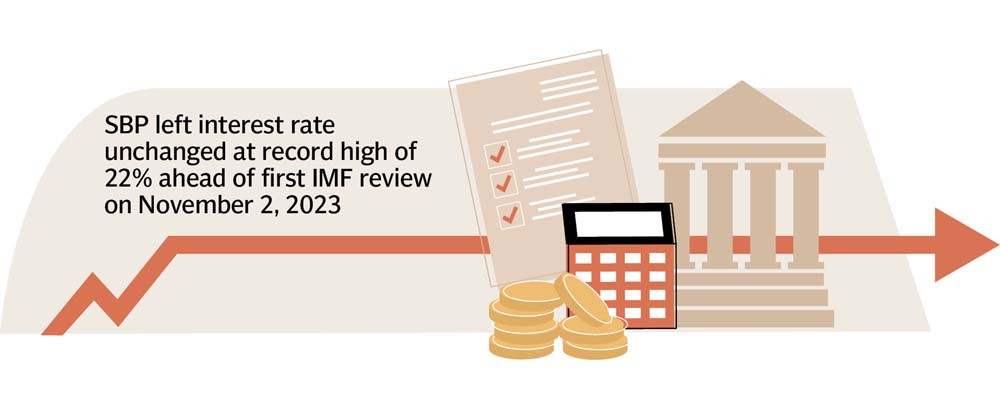SBP maintains tight monetary policy
Leaves policy rate unchanged but signals it has peaked out at current level

Pakistan’s central bank on Monday left its benchmark policy rate unchanged at a record high of 22% ahead of International Monetary Fund’s (IMF) first review under the $3 billion loan programme.
“The MPC (monetary policy committee) noted that a successful and timely completion of the upcoming IMF-SBA (standby arrangement) review would help unlock other multilateral and bilateral financing,” the State Bank said while announcing the monetary policy.
The bank said it would maintain the “tight monetary policy” for now, but signaled the policy rate had peaked out at the current level.
In its latest monetary policy statement for the next six weeks, the State Bank of Pakistan (SBP) reiterated its earlier view “that the real policy rate (inflation minus policy rate) is significantly positive on a 12-month forward-looking basis.”
The bank avoided cutting the rate now as it seemed to be waiting for inflation to come down from October onwards.
It said inflation hit a four-month high at 31.4% in September 2023 in line with its forecast. It believes that inflation will aggressively decelerate in the second half (Jan-Jun) of current fiscal year.
Read SBP keeps key policy rate unchanged at 22pc
Experts anticipate the central bank will make the first cut in its policy rate between December 2023 and March 2024, noting that the expected reduction in monthly inflation to 15-16% by the end of June 2024 will encourage the bank to make a cumulative reduction of 4-5 percentage points in the policy rate.
With the downward rate revision, the economic activities in the country will get some boost.
“Recent data on economic activity reinforces the MPC’s earlier expectation of a moderate growth (2-3%) for this year,” the SBP said. The SBP left the policy rate unchanged for the third time in a row in the past four months.
Risk factors
The SBP said that the current policy rate was appropriate to bring inflation down to the medium-term target of 5-7% by the end of FY25. “However, the MPC noted that this outlook is based on continued fiscal consolidation and timely realisation of planned external inflows.”
The central bank also highlighted risks to the expected deceleration in inflation, saying the Middle Eastern crisis (Palestine-Israel war) and associated volatility in global petroleum product prices may prolong the period of high inflation.
“While the recent volatility in global oil prices as well as the increase in gas tariffs from November 2023 pose some risks to the FY24 outlook for inflation and the current account, the MPC also noted some offsetting factors.
“These include the targeted fiscal consolidation in Q1, improvement in market availability of key commodities, and the alignment of interbank and open market exchange rates.” Core inflation (non-food and non-energy) persisted at elevated levels around 21% during the last four months.

Economic activities rise
Latest estimates of major Kharif crops including cotton, paddy (rice), sugarcane and maize show a considerable increase compared to last year. These improved crop estimates were supported by higher fertiliser offtake and better water availability, the bank said.
Also, moderate recovery in other key indicators like cement, POL (petroleum, oil and lubricants) and auto sales is gaining traction. Moreover, large-scale manufacturing (LSM) output indicated a gradual improvement in the first two months of this year, with major contribution coming from domestic-oriented sectors, it added.
Read more Only monetary rate can 'fix economy'
The central bank said it had noted four major developments since its last monetary policy in September 2023. First, the initial estimates for Kharif crops are encouraging and will have positive effects on other key sectors of the economy.
Second, the current account deficit narrowed considerably in August and September, which helped to stabilise the SBP’s foreign exchange reserves amidst tepid external financing in the two months.
Third, fiscal consolidation remained on track, with both fiscal and primary balances improving during 1QFY24.
Fourth, while core inflation remains sticky, inflation expectations of both consumers and businesses improved in the latest pulse surveys. However, global oil prices remain quite volatile and the conflict in the Middle East makes its outlook even more uncertain.
The SBP noted that the current account deficit improved 58% to $947 million in Jul-Sept FY24 compared to the same period of last year, while almost leveling out in September 2023. Both exports and workers’ remittances improved in September over the preceding two months. Improved inflows in the interbank market helped stabilise the foreign exchange reserves around $7.5 billion as of October 20, 2023.
In the first quarter of FY24, the fiscal deficit improved amid better revenue collection and restrained spending. FBR’s revenue showed 24.9% growth over the same period of last year.
Similarly, non-tax revenue almost doubled mainly due to a sharp rate-driven increase in petroleum development levy (PDL) collection. Expenditures remained at last year’s level, supported by a considerable reduction in subsidies and grants.
Published in The Express Tribune, October 31st, 2023.
Like Business on Facebook, follow @TribuneBiz on Twitter to stay informed and join in the conversation.


















COMMENTS
Comments are moderated and generally will be posted if they are on-topic and not abusive.
For more information, please see our Comments FAQ